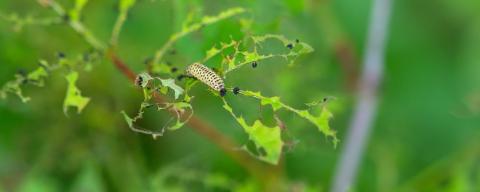Using Growing Degree Days to Predict Insect Pests in the Landscape
Does weather factor into your landscape pest management decisions? Keeping track of weather, and specifically daily temperatures, can help you fine tune the timing of pest management activities, contributing to significant savings in costs of labor, materials, and plant injury.
You may have a good idea of when to expect certain insect pests to be active in the landscape based on your experience and observations from previous years. However, we know that weather conditions are unpredictable and can vary significantly year to year, and that temperature affects the rate at which insects develop. This means the best time to scout for and manage individual pests will also vary year to year. You likely noticed leaf and flower buds developing early and rapidly during the recent April warm spell. These warm temperatures sped the early development of insects as well.
Tracking the seasonal accumulation of heat units, termed Growing Degree Days (GDD), can be a powerful tool in predicting when pests will be active and when they will be most susceptible to your control measures. The rate at which an insect develops is directly correlated with the temperatures in the surrounding environment, with warmer temperatures leading to faster development. Every insect has a lower threshold temperature (base temperature) and an upper threshold temperature, and insect development occurs only when average temperatures fall between these two thresholds.
The exact lower threshold temperature has been determined for only a fraction of the insects you will encounter, however researchers have found that assuming a lower threshold of 50oF allows for accurate estimates for the development of most insects in NH landscapes. The estimates are not exact, but they will be much more accurate than relying on the calendar to predict pest activity.
As soon as average daily temperatures exceed 50oF in the spring, GDD begin accumulating. The average temperature is calculated by adding the day’s low temperature with the day’s high temperature, and dividing by 2. For example, if the low temperature on April 15 was 43oF and the high temperature that day was 59oF, the average temperature would be 51. To calculate the GDD for a single day, the baseline temperature of 50oF is subtracted from the day’s average temperature. In this example, 51-50 = 1 GDD accumulated. If the low temperature on April 16 was 42oF and the high temperature was 66oF, 4 GDD would be accumulated that day ([42+66]/2 – 50 = 4). Each day, the GDD are added to the season’s total accumulation. When the average temperature is below 50oF, and a negative number is calculated, the GDD accumulated is zero (negative values are not used).
By looking at many years of recorded GDD data, we can map on a calendar when we expect GDD milestones to be reached in NH. This gives us a good idea of when individual pests will be active. We can further fine-tune our estimates by tracking the current year’s GDD. Using current GDD, we can predict pest activity to within a narrow window of time.
UNH Extension provides resources to help you effectively use GDD in your pest management plans. UNH Extension partners with the Network for Environmental and Weather Applications (NEWA) to host a collection of weather stations across the state. The data from these weather stations is freely available online at https://newa.cornell.edu/. Because daily temperatures (and accumulated GDD) can vary significantly from one area of the state to another, it is best to use temperature data as local to your landscape as possible. To utilize the current accumulated GDD data available through NEWA, first find the weather station closest to your landscape on the online NEWA map. Click on the closest weather station and scroll down to ‘Weather Tools’. Here, you will find a ‘DD Calculator.’ Within the tool, enter a start date (March 1 is recommended) and an end date (today’s date). Under ‘Degree Day Type’, select the base threshold of 50oF. The results will provide you with the daily and seasonal accumulations of GDD for that location.
Looking at the Brentwood, NH weather station, I see that this year (2023), the first GDD was accumulated on April 4. We then had a stretch of days when the average temperature didn’t reach 50oF, so no additional GDD were accumulated for a while. Then, April 11-16, we had a stretch of warm days, and we had a spike in GDD accumulation, reaching a total of 49 GDD by April 16. Accumulation of GDD then paused as temperatures again dropped. In the landscape, the period of warm temperatures moved insects along in their development.
Knowing that insect development is correlated with accumulation of GDD, we can use this local data to guide our pest scouting and management activities. Several resources are available that provide lists of GDD thresholds for individual pests which indicate when we can expect these pests to be active and the range of GDD when control measures will be most effective (see The New Hampshire Department of Agriculture, Markets & Food, UMass Extension’s Landscape Message, and Cornell Extension).
Across New Hampshire, we have accumulated approximately 40 – 70 GDD so far this year, as of late April. Historically, southern NH reaches 50 GDD around mid-May, so development is occurring a few weeks early so far this year.
Here are just a few of the landscape insect pests that become active below 100 GDD. Now is the time for scouting!
● Balsam Twig Aphid ● Spruce Gall Adelgid ● Eastern Tent Caterpillar ● European Pine Sawfly ● Hemlock Looper ● Viburnum Leaf Beetle ● White Pine Weevil ●
If you would like further guidance in incorporating Growing Degree Days into your pest management plans, contact Amy Papineau, Extension Field Specialist, amy.papineau@unh.edu, 603-272-6497.
Extension Services & Tools That Help NH Farmers Grow
Newsletters: Choose from our many newsletters for production agriculture
Receive Pest Text Alerts - Text UNHIPM to (866) 645-7010


